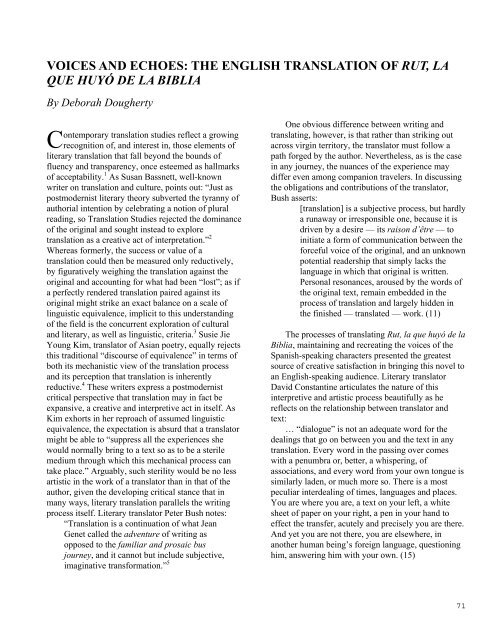their - The University of Texas at Dallas
their - The University of Texas at Dallas
their - The University of Texas at Dallas
You also want an ePaper? Increase the reach of your titles
YUMPU automatically turns print PDFs into web optimized ePapers that Google loves.
VOICES AND ECHOES: THE ENGLISH TRANSLATION OF RUT, LA<br />
QUE HUYÓ DE LA BIBLIA<br />
By Deborah Dougherty<br />
C<br />
ontemporary transl<strong>at</strong>ion studies reflect a growing<br />
recognition <strong>of</strong>, and interest in, those elements <strong>of</strong><br />
literary transl<strong>at</strong>ion th<strong>at</strong> fall beyond the bounds <strong>of</strong><br />
fluency and transparency, once esteemed as hallmarks<br />
<strong>of</strong> acceptability. 1 As Susan Bassnett, well-known<br />
writer on transl<strong>at</strong>ion and culture, points out: “Just as<br />
postmodernist literary theory subverted the tyranny <strong>of</strong><br />
authorial intention by celebr<strong>at</strong>ing a notion <strong>of</strong> plural<br />
reading, so Transl<strong>at</strong>ion Studies rejected the dominance<br />
<strong>of</strong> the original and sought instead to explore<br />
transl<strong>at</strong>ion as a cre<strong>at</strong>ive act <strong>of</strong> interpret<strong>at</strong>ion.” 2<br />
Whereas formerly, the success or value <strong>of</strong> a<br />
transl<strong>at</strong>ion could then be measured only reductively,<br />
by figur<strong>at</strong>ively weighing the transl<strong>at</strong>ion against the<br />
original and accounting for wh<strong>at</strong> had been “lost”; as if<br />
a perfectly rendered transl<strong>at</strong>ion paired against its<br />
original might strike an exact balance on a scale <strong>of</strong><br />
linguistic equivalence, implicit to this understanding<br />
<strong>of</strong> the field is the concurrent explor<strong>at</strong>ion <strong>of</strong> cultural<br />
and literary, as well as linguistic, criteria. 3 Susie Jie<br />
Young Kim, transl<strong>at</strong>or <strong>of</strong> Asian poetry, equally rejects<br />
this traditional “discourse <strong>of</strong> equivalence” in terms <strong>of</strong><br />
both its mechanistic view <strong>of</strong> the transl<strong>at</strong>ion process<br />
and its perception th<strong>at</strong> transl<strong>at</strong>ion is inherently<br />
reductive. 4 <strong>The</strong>se writers express a postmodernist<br />
critical perspective th<strong>at</strong> transl<strong>at</strong>ion may in fact be<br />
expansive, a cre<strong>at</strong>ive and interpretive act in itself. As<br />
Kim exhorts in her reproach <strong>of</strong> assumed linguistic<br />
equivalence, the expect<strong>at</strong>ion is absurd th<strong>at</strong> a transl<strong>at</strong>or<br />
might be able to “suppress all the experiences she<br />
would normally bring to a text so as to be a sterile<br />
medium through which this mechanical process can<br />
take place.” Arguably, such sterility would be no less<br />
artistic in the work <strong>of</strong> a transl<strong>at</strong>or than in th<strong>at</strong> <strong>of</strong> the<br />
author, given the developing critical stance th<strong>at</strong> in<br />
many ways, literary transl<strong>at</strong>ion parallels the writing<br />
process itself. Literary transl<strong>at</strong>or Peter Bush notes:<br />
“Transl<strong>at</strong>ion is a continu<strong>at</strong>ion <strong>of</strong> wh<strong>at</strong> Jean<br />
Genet called the adventure <strong>of</strong> writing as<br />
opposed to the familiar and prosaic bus<br />
journey, and it cannot but include subjective,<br />
imagin<strong>at</strong>ive transform<strong>at</strong>ion.” 5<br />
One obvious difference between writing and<br />
transl<strong>at</strong>ing, however, is th<strong>at</strong> r<strong>at</strong>her than striking out<br />
across virgin territory, the transl<strong>at</strong>or must follow a<br />
p<strong>at</strong>h forged by the author. Nevertheless, as is the case<br />
in any journey, the nuances <strong>of</strong> the experience may<br />
differ even among companion travelers. In discussing<br />
the oblig<strong>at</strong>ions and contributions <strong>of</strong> the transl<strong>at</strong>or,<br />
Bush asserts:<br />
[transl<strong>at</strong>ion] is a subjective process, but hardly<br />
a runaway or irresponsible one, because it is<br />
driven by a desire — its raison d’être — to<br />
initi<strong>at</strong>e a form <strong>of</strong> communic<strong>at</strong>ion between the<br />
forceful voice <strong>of</strong> the original, and an unknown<br />
potential readership th<strong>at</strong> simply lacks the<br />
language in which th<strong>at</strong> original is written.<br />
Personal resonances, aroused by the words <strong>of</strong><br />
the original text, remain embedded in the<br />
process <strong>of</strong> transl<strong>at</strong>ion and largely hidden in<br />
the finished — transl<strong>at</strong>ed — work. (11)<br />
<strong>The</strong> processes <strong>of</strong> transl<strong>at</strong>ing Rut, la que huyó de la<br />
Biblia, maintaining and recre<strong>at</strong>ing the voices <strong>of</strong> the<br />
Spanish-speaking characters presented the gre<strong>at</strong>est<br />
source <strong>of</strong> cre<strong>at</strong>ive s<strong>at</strong>isfaction in bringing this novel to<br />
an English-speaking audience. Literary transl<strong>at</strong>or<br />
David Constantine articul<strong>at</strong>es the n<strong>at</strong>ure <strong>of</strong> this<br />
interpretive and artistic process beautifully as he<br />
reflects on the rel<strong>at</strong>ionship between transl<strong>at</strong>or and<br />
text:<br />
… “dialogue” is not an adequ<strong>at</strong>e word for the<br />
dealings th<strong>at</strong> go on between you and the text in any<br />
transl<strong>at</strong>ion. Every word in the passing over comes<br />
with a penumbra or, better, a whispering, <strong>of</strong><br />
associ<strong>at</strong>ions, and every word from your own tongue is<br />
similarly laden, or much more so. <strong>The</strong>re is a most<br />
peculiar interdealing <strong>of</strong> times, languages and places.<br />
You are where you are, a text on your left, a white<br />
sheet <strong>of</strong> paper on your right, a pen in your hand to<br />
effect the transfer, acutely and precisely you are there.<br />
And yet you are not there, you are elsewhere, in<br />
another human being’s foreign language, questioning<br />
him, answering him with your own. (15)<br />
71

















